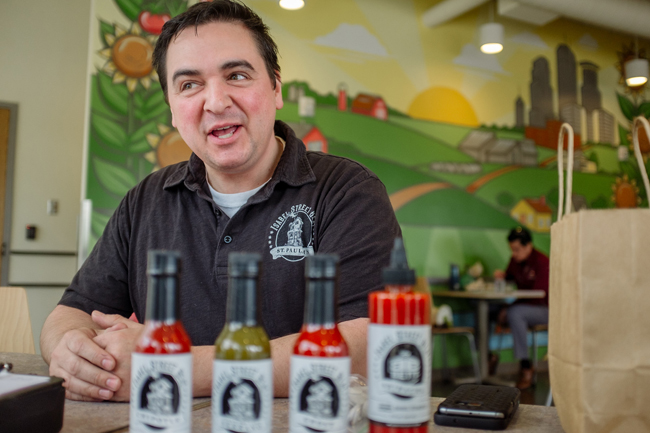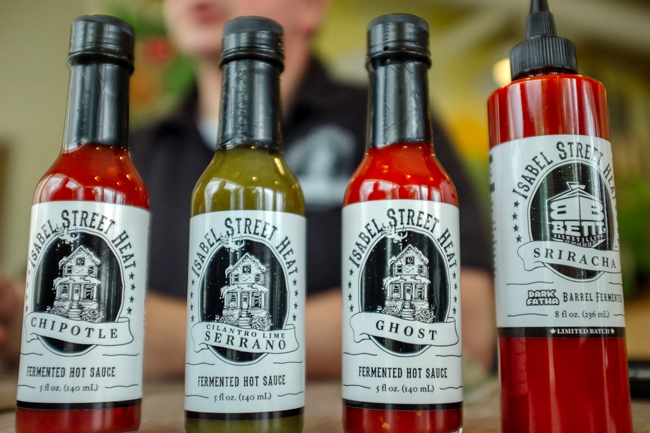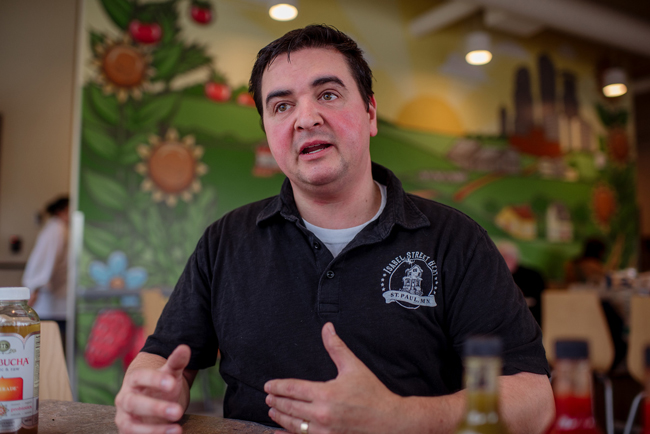
Hot sauce isn’t always seen as the territory of culinary professionals. Every freelancer and amateur under the sun has seemingly concocted a hot sauce, and most of them have taken them to market. With few exceptions, there’s not a lot of substance: plenty of spicy heat, a cool label, a sting of vinegar, but little in the way of depth of flavor. Many lines of hot sauce have varieties differentiated only by the amount of raw heat manifestd in mild vs. medium vs. hot. Otherwise, the same uninspired base sets the tone for how they taste.
The sauces of Isabel Street Heat are a different prospect indeed. Founder Tony Stoy is a former restaurant chef, and his culinary brain has imposed upon his sauces some welcome traits — depth, balance, and substance — via the magic of fermentation. These sauces aren’t mere capsaicin vehicles; they’re legitimate condiments in their own right.

Cilantro Lime Serrano is a whirlwind of flavor — herbaceous brightness up front kicked to a higher plane by the application of acidic notes of lime followed by a moderate burn from the peppers that fades cleanly, setting the taster up for the next bite.
The Chipotle variety has a massive kick of natural smoke that plays with the funky, warm, modestly spicy nature of the peppers that power the sauce.
And while the Ghost Pepper is undeniably hot (“there are about 5-6 ghost peppers per bottle,” warns Stoy), it’s not inedibly fiery, and a little will go a long way to steer a big dish like a chili or stew toward a brighter, hotter destiny.
What all these varieties have in common is a mellow, fully developed sense of flavor that comes from the fermentation process, which makes for a true marriage of the sauces’ various ingredients and helps promote a big, balanced kick in every bite. They retail for $7-$10 at area stores and online, which is expensive only if you don’t take into account their tremendous and complex punch of flavor.

Fermentation, an expensive process in its own right, is the key to the sauces’ power.
“With that three-month fermentation, the pH starts to go down, and it breaks down the fibers and the pulp of the peppers, which makes it easy to blend with the vinegars,” says Stoy. “During the fermentation, there’s a salt cap that sits on top. That salt helps promote the fermentation and creates an anaerobic environment for the mash, so the colors stay really bright. I’ll also take that salt and dry it. The salt from the mild sauce I’ll mix with fresh-cracked black pepper so we have a dry rub called the St. Paul Mix.”
The salt cap from the hotter sauces is blended and slow roasted and marketed as Habanero Salt, an ideal rub for vegetables and other mild foods that can use a kick of heat and seasoning.
Stoy, with three years of experience cooking in New Orleans (and time before that cooking in Maine), analyzes his sauce at a level of seriousness that helps you understand the thought that goes into each bottle he sells. Of the Ghost Pepper variety, he says:
“There’s a good heat level, but you’ve got some vinegars in that fermentation that change the flavor. As you first taste it, you get a really good taste of that ghost pepper, and then about 2-3 seconds later, the vinegar and salt tones start to move back. And then the heat starts to slowly move forward and flatten out your tongue, and that’ll happen for about 15 seconds. And then the sides of your tongue will start to come back in, and at about 20 seconds all the heat will be transferred to the middle of your tongue. From there, it’s like a balloon, and it gets warmer and warmer.”
In a world choked by simplified, commoditized, bland, and downright dull food, we sometimes need a condiment this thoughtfully made to cut through the fog and once again clear the way to the power of real flavor.
